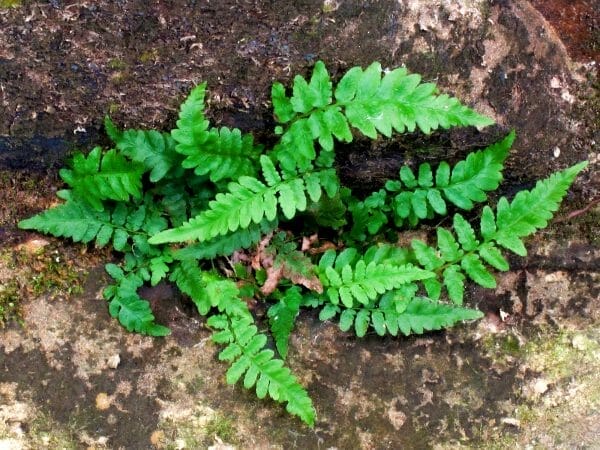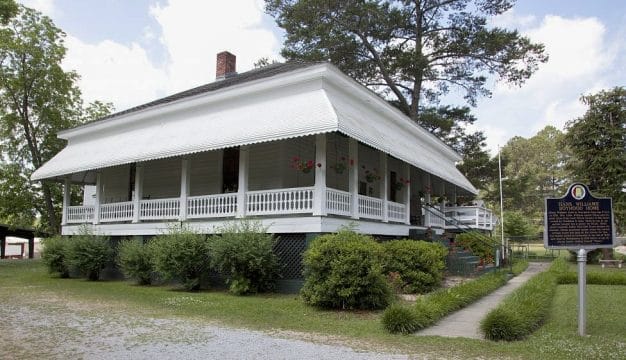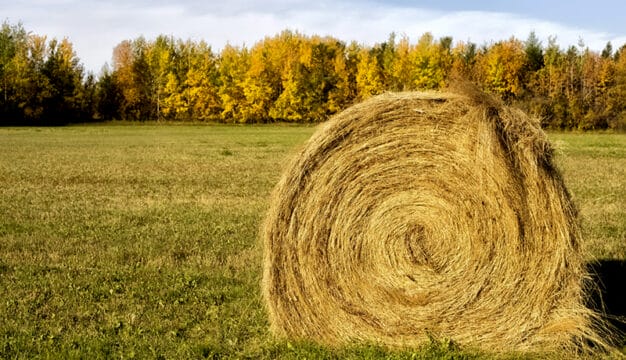Alabama Streak-Sorus Fern
The Alabama streak-sorus fern (Leptogramma burksiorum) is one of the world’s rarest fern species, only known from a small, five-mile stretch of the Sipsey Fork of the Black Warrior River in the portion of the William B. Bankhead National Forest in Winston County. It grows exclusively under large, steep-walled sandstone cliffs and “rockhouses,” or sheltered cave-like sandstone overhangs at the base of cliff systems, growing only within 50 feet of the Sipsey Fork. Here, the fern grows in a very specific microclimate, maintained by a combination of shade, moisture, and high humidity from the Sipsey Fork, rockhouses within the river gorge, and the rich hardwood and hemlock forest community found above these cliffs. It is listed as federally threatened by the U.S. Fish and Wildlife Service (USFWS) for its overall rarity, notable uniqueness, and potential threats from human activity.
 Alabama Streak-Sorus Fern
Lloyd C. Crawford, a U.S. botanist and pteridologist (a person who specifically studies ferns) first discovered the Alabama streak-sorus fern in 1949, five miles east of Double Springs, Winston County, in sandstone fissures at a single site on the Sipsey Fork. Confused by the find, he gathered and preserved specimens of the fern to compare to it to scientific-grade specimens of other ferns in scientific collections. He noticed striking similarities between it and other streak-sorus ferns collected from Chihuahua, Mexico. Using a limited set of morphological characters, or variable physical traits, he determined that there were three varieties of streak-sorus fern, two of which occur in Mexico, Guatemala, and Honduras, and the third known only from this single Sipsey River site. He named each accordingly as a variety of Thelypteris pilosa, calling the Sipsey River fern Thelypteris pilosa var. alabamensis. Further research into the variety’s relationship with its Mexican relatives revealed that the Alabama streak-sorus fern is distinct enough to be elevated to species level, officially being named as Thelypteris burksiorum by botanists J. Eddie Watkins and Don R. Farrar in 2002. Streak sorus ferns, as well the broader maiden fern family, Thelypteridaceae, have been subject to extensive research in their evolutionary relationships and taxonomy. After many years of discussion, scientists concluded that the Alabama streak-sorus fern and its close relatives would be best classified as belonging to the genus Leptogramma; researchers Yi-Hang Chang and Li-Yaung Kuo presented a taxonomic recombination for the species, moving it to its new and currently accepted name, Leptogramma burksiorum. The genus name means “narrow letter” in Greek, and the species name is in honor of Alabama conservationists Mary Ivy Burks and her husband, Robert Burks, who were tireless advocates for the establishment and protection of the Sipsey Wilderness and Bankhead National Forest.
Alabama Streak-Sorus Fern
Lloyd C. Crawford, a U.S. botanist and pteridologist (a person who specifically studies ferns) first discovered the Alabama streak-sorus fern in 1949, five miles east of Double Springs, Winston County, in sandstone fissures at a single site on the Sipsey Fork. Confused by the find, he gathered and preserved specimens of the fern to compare to it to scientific-grade specimens of other ferns in scientific collections. He noticed striking similarities between it and other streak-sorus ferns collected from Chihuahua, Mexico. Using a limited set of morphological characters, or variable physical traits, he determined that there were three varieties of streak-sorus fern, two of which occur in Mexico, Guatemala, and Honduras, and the third known only from this single Sipsey River site. He named each accordingly as a variety of Thelypteris pilosa, calling the Sipsey River fern Thelypteris pilosa var. alabamensis. Further research into the variety’s relationship with its Mexican relatives revealed that the Alabama streak-sorus fern is distinct enough to be elevated to species level, officially being named as Thelypteris burksiorum by botanists J. Eddie Watkins and Don R. Farrar in 2002. Streak sorus ferns, as well the broader maiden fern family, Thelypteridaceae, have been subject to extensive research in their evolutionary relationships and taxonomy. After many years of discussion, scientists concluded that the Alabama streak-sorus fern and its close relatives would be best classified as belonging to the genus Leptogramma; researchers Yi-Hang Chang and Li-Yaung Kuo presented a taxonomic recombination for the species, moving it to its new and currently accepted name, Leptogramma burksiorum. The genus name means “narrow letter” in Greek, and the species name is in honor of Alabama conservationists Mary Ivy Burks and her husband, Robert Burks, who were tireless advocates for the establishment and protection of the Sipsey Wilderness and Bankhead National Forest.
 Alabama Streak-Sorus Fern Habitat
Alabama streak-sorus fern is quite distinctive compared to other ferns known in Alabama. It grows strictly as a lithophyte, a specialized type of plant with the ability to grow in minimal soil substrate over rock. This species largely grows on the Pottsville Sandstone, a common type of sandstone found throughout the Cumberland Plateau physiographic section. It grows much like the cliff-loving spleenworts of the genus Asplenium, but the Alabama streak-sorus fern prefers darkened rock shelters with diffuse light, areas where not many other fern or plant species thrive. It is usually associated only with other rockhouse-loving species, such as the Appalachian bristle fern (Vandenboschia boschiana) and the Appalachian shoestring fern (Vittaria appalachiana). It is distinguished from other fern species by its growth patterns, as well as clustered fronds, blunt rather than pointed “leaves” (known as pinnae) on the frond, and a fine, dense covering of hairs on all parts of the plant. Perhaps the most readily distinguishing characteristic is its lack of an indusium, a thin, membrane-like covering over a fertile frond’s often rust-colored spore-producing areas, termed sori (plural of sorus). This membrane splits open after a fern’s spores ripen and mature for release and is an important physical trait, known in research as a morphologic tool, for identifying many fern species. Many ferns found in Alabama possess indusia (plural of indusium); however, Alabama streak-sorus ferns do not, instead possessing “naked” sori on the undersides of their fronds. This characteristic, in combination with its straight sori, are the source of its common name as a “streak-sorus” fern.
Alabama Streak-Sorus Fern Habitat
Alabama streak-sorus fern is quite distinctive compared to other ferns known in Alabama. It grows strictly as a lithophyte, a specialized type of plant with the ability to grow in minimal soil substrate over rock. This species largely grows on the Pottsville Sandstone, a common type of sandstone found throughout the Cumberland Plateau physiographic section. It grows much like the cliff-loving spleenworts of the genus Asplenium, but the Alabama streak-sorus fern prefers darkened rock shelters with diffuse light, areas where not many other fern or plant species thrive. It is usually associated only with other rockhouse-loving species, such as the Appalachian bristle fern (Vandenboschia boschiana) and the Appalachian shoestring fern (Vittaria appalachiana). It is distinguished from other fern species by its growth patterns, as well as clustered fronds, blunt rather than pointed “leaves” (known as pinnae) on the frond, and a fine, dense covering of hairs on all parts of the plant. Perhaps the most readily distinguishing characteristic is its lack of an indusium, a thin, membrane-like covering over a fertile frond’s often rust-colored spore-producing areas, termed sori (plural of sorus). This membrane splits open after a fern’s spores ripen and mature for release and is an important physical trait, known in research as a morphologic tool, for identifying many fern species. Many ferns found in Alabama possess indusia (plural of indusium); however, Alabama streak-sorus ferns do not, instead possessing “naked” sori on the undersides of their fronds. This characteristic, in combination with its straight sori, are the source of its common name as a “streak-sorus” fern.
The USFWS first listed the Alabama streak-sorus fern as threatened in 1992 in recognition of human-caused threats to its populations and its extreme dependence on its specific microclimate. The locality of the type specimen for this species was destroyed in the 1960s during the construction of the U.S. Highway 278 bridge over the Sipsey Fork east of Double Springs. Fortunately, the fern was rediscovered in the 1970s on the Sipsey Fork just north of Double Springs. Approximately 20 colonies along a five-mile stretch of this pristine river system have been located in recent years since its rediscovery. The greatest threats for this species involve altering its microhabitat, where river levels, light levels, the overall condition of the stream corridor, rockhouses, and overlying hardwood forest canopy all contribute to maintaining ideal humidity for the ferns. These rockhouses behave much like caves, moderating temperature and moisture, but are sensitive to disturbance. Fortunately, future land development is likely minimal because much of the species and its habitat occurring on U.S. Forest Service land. However, Alabama streak-sorus fern, like many other microhabitat-sensitive species, may face its biggest challenge yet with the onset of climate change.
Further Reading
- Alabama Ecological Services Field Office. Alabama streak-sorus fern, Thelypteris pilosa var. alabamensis (=T. burksiorum) 5-Year Review: Summary and Evaluation. Daphne, Ala.: U.S. Fish and Wildlife Service, 2021.
- Crawford, Lloyd C. “A new fern for the United States.” American Fern Journal 41 (January-March 1951): 15-20.
- Fawcett, Susan, and Alan R. Smith. A Genetic Classification of the Thelypteridaceae. Fort Worth, Tex.: Botanical Research Institute of Texas Press, 2021.
- Gunn, Scott C. Alabama Streak-Sorus Fern Recovery Plan. Jackson, Miss.: U.S. Fish and Wildlife Service, 1996.
- Watkins, James E., and Donald R. Farrar. “A new name for an old fern from North Alabama.” American Fern Journal 92 (April-June 2002): 171-178.



